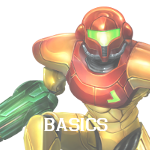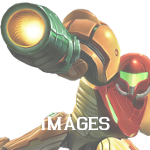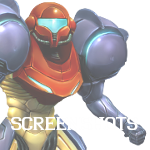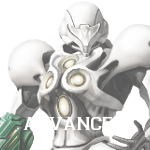Navigation menu
User:Embyr 75/Sandbox
My Sandbox! :D
Metroid in the Super Smash Bros. Series
The Super Smash Bros. Series is made up of several fighting games published by Nintendo that feature characters from various established Nintendo franchises and pits them against one another in arena battles. Samus Aran has made an appearance as a playable character in every installment released thus far, and has also been playable in her Zero Suit on multiple occasions.
Various other references to the Metroid universe have been included throughout the games, including Metroid-themed stages, music, bosses, items, assist trophies, stickers, collectible trophies, and other cameos.
Super Smash Bros.
- Main article: Super Smash Bros.
Characters
- Samus Aran appears in her Varia Suit as one of the 12 playable characters in the game. The game includes four other color palettes which allows the Varia Suit to appear black, pink, purple, or green, as well as the traditional orange. She uses a variety of melee attacks as well as her Flamethrower, Grapple Beam, Charge Beam, Morph Ball Bombs, and Screw Attack in combat.
Stages
- Planet Zebes appears as a stage for combat, inspired by the original Planet Zebes. It features an rising and falling acid hazard and background cameos such as Wavers and even Ridley.
Music
Music featured from Metroid include tracks 8 and 18.
- 8 is a remix of the Brinstar music from the original Metroid, used as background music on the Planet Zebes stage.
- 41 is an orchestration of the item acquisition fanfare, used as Samus's victory fanfare, respectively.
Super Smash Bros. Melee
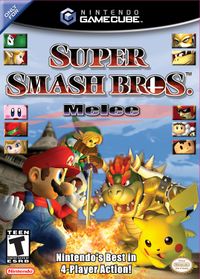
- Main article: Super Smash Bros. Melee
Characters
- Samus Aran returns as a veteran fighter in Melee with the same five color palettes available in Super Smash Bros. Her arsenal includes the same weapons as in the previous installment, with the addition of Missiles.
Stages
- Planet Zebes: Brinstar appears as a stage for combat, inspired by the original Brinstar area. In many ways it's nearly identical to the Planet Zebes stage from Super Smash Bros., complete with an acid hazard. The large fleshy organism in the background is shaped like a brain, perhaps a tip of the hat to Mother Brain, or even a rudimentary image of her.
- Planet Zebes: Brinstar Depths is the second Metroid-themed stage in Melee, loosely inspired by Kraid area. Kraid appears in the background of this stage, spinning the central platform occasionally during battles, but otherwise the stage bears little resemblance to any areas of Brinstar in the Metroid games.
- The Brinstar Escape Shaft appears briefly in the 1-player adventure mode, possibly inspired by a similar shaft in Super Metroid. In this level the character being used at the time must ascend to the top of a large underground shaft using multiple metal platforms within a set time limit.
Items
- The Screw Attack was introduced in Melee as the first Metroid-themed item. The item can be held, adding a spin to a character's normal jumps that inflict minor damage, or thrown at an opponent, causing them in execute a spinning jump as a disruption tactic.
Music
Music from the Metroid series included in this game include tracks 7, 8, and 41.
- 7: Brinstar plays on the Brinstar stage and is a medley of a remixed Brinstar theme, the "game start" fanfare heard when one resumes a gamefile in the original Metroid, and the original Metroid title theme.
- 8: Brinstar Depths plays on the Brinstar Depths stage and is a remix of the music heard in the original Metroid when Samus is about to combat Kraid and a short bridge consisting of the item room music in the same game.
- 41: Samus's Victory is an orchestration of the item acquisition fanfare and is used as Samus's victory fanfare.
Trophies
(Samus Aran's three game trophies, Screw Attack, Kraid, Chozo Statue, Samus' Starship, Metroid, Ridley, Samus Unmasked)
Super Smash Bros. Brawl

- Main article: Super Smash Bros. Brawl
Characters
- Samus Aran makes a third appearance in the series in Brawl. Her arsenal and attacks are nearly identical to those used in Melee but includes a powerful final smash known as the Zero Laser, a huge beam fired from her Arm Cannon that blasts her armor away, allowing her to continue fighting in her Zero Suit.
- Zero Suit Samus makes her first appearance in the Super Smash Bros. series in Brawl. Aside from an array of melee attacks, she also utilizes her Paralyzer gun in combat, with added functionality not previous seen in any Metroid games including the Plasma Wire and Plasma Whip. Her final smash re-materializes her Power Suit.
Stages
- Norfair appears as a stage for combat, inspired by the Norfair area. It features five platforms hovering over lava that will rise and fall occasionally, as well as spray from the sides, bubble up from beneath, and even completely cover the stage in a large wave.
- Frigate Orpheon is the first stage taken from the Metroid Prime series, and is inspired by the Reactor Core area of Frigate Orpheon. A Parasite Queen (presumably the one fought by Samus in Metroid Prime) often appears in the background. Occasionally, the entire stage will flip over.
- Melee Stages: Brinstar reappears as a Melee stage and is identical to its previous appearance.
Items
- The Screw Attack appears again, and has identical functionality to the Melee incarnation, except it cannot be thrown at enemies.
Assist Trophies
- A Metroid can be summoned using an assist trophy to drain an opponent's energy. It will latch onto an enemy character cause damage in the same manner as Metroids have throughout the Metroid series.
Bosses
- Ridley appears as a boss during the Subspace Emissary mode. Ridley is fought on a large, flat platform, and uses his powerful wings, tail, and claws in a variety of melee attacks.
- Meta Ridley appears later in the Subspace Emissary mode after his initial defeat. Meta Ridley chases Captain Falcon's Falcon Flyer and uses various fiery projectiles fired from his mouth and swipes of his claws to damage his opponents.
Music
Music from the Metroid series in Brawl includes 13 different tracks.
- Main Theme (Metroid) A rock styled remix of the Brinstar theme from the first Metroid title. Aside from the vocals at the beginning of the track, this is taken almost directly from Metroid Prime Pinball, with the insertion of some extra instruments and the addition of the original Brinstar NES-like remix. It is used on the Norfair stage.
- Ending (Metroid) - An orchestrated version of the credits theme used in both the original Metroid and its remake Metroid Zero Mission. It is used on the Norfair stage. This song is also played during both Samus and Zero Suit Samus' Classic Mode credits.
- Norfair - A quirky remix of the lesser known Norfair theme from the original Metroid game. It is the theme of the Norfair stage.
- Theme of Samus Aran, Space Warrior - An orchestration of the credits theme of the SNES hit Super Metroid. It is used on the Norfair stage.
- Vs. Ridley - A completely redone version of Ridley's theme that is featured in several Metroid games and originated in Super Metroid. It is used on the Frigate Orpheon stage.
- Vs. Parasite Queen - Taken directly from Metroid Prime, this was the track that played when Samus fought the Parasite Queen during the opening section of the game. It is used on the Frigate Orpheon stage.
- Opening/Menu (Metroid Prime) - A medley of two tracks from Metroid Prime--the title screen and the credits theme (which itself was an extension of the menu theme). With the exception of the vocals at the beginning, the title screen theme is taken directly from the game, while the credits theme is arranged. It is the theme of the Frigate Orpheon stage.
- Sector 1 - An orchestrated version of the background music of the first mission in Sector 1 in Metroid Fusion. It is used on the Frigate Orpheon stage.
- Vs. Meta Ridley - Taken directly from Metroid Prime, this was the background music that played during the fight against Meta Ridley. This same, unaltered track was also used in Metroid Prime 3: Corruption. It is used on the Frigate Orpheon stage.
- Multiplayer (Metroid Prime 2) - A track taken directly from the multiplayer mode of Metroid Prime 2: Echoes, which itself was a techno remix of the Brinstar background music from Super Metroid. It is used on the Frigate Orpheon stage.
- Brinstar (Melee) - Taken directly from Melee. It is used on the Brinstar stage.
- Brinstar Depths (Melee) - Taken directly from Melee. It is used on the Brinstar stage.
- Samus's Victory Theme - The "got item" fanfare featured in every single Metroid game to date, except Metroid: Other M.
Trophies
(Samus Aran, Zero Suit Samus, Zero Laser, Power Suit Samus, Screw Attack, Metroid, Samus (Fusion Suit), Samus (Power Suit), Samus (Varia Suit), Samus (Gravity Suit), Samus (Dark Suit), Dark Samus, Ridley, Meta Ridley, Kanden, Spire, Weavel, Noxus, Trace, Sylux, Luminoth, Space Pirate, Parasite Queen, Sheegoth, Metroid Prime (Core), Metroid Prime (Exo), Gunship)
Stickers
(Chozo Statue, Dark Suit Samus, Dark Samus, Federation Trooper, Gravity Suit Samus, Gunship, Kanden, Kraid, Metroid (Metroid: Zero Mission), Metroid (Metroid Pinball), Morph Ball, Mother Brain (Metroid: Zero Mission), Ridley (Metroid: Zero Mission), Ridley (Metroid), Running Zero Suit Samus, Samus (Metroid), Samus (Metroid Prime 2: Echoes), Samus (Metroid Fusion), Special Token, Starship, Starship (Metroid Prime Hunters), Sylux, Warrior Ing, Zebes Inhabitant, Zero Suit Samus)
Super Smash Bros. 4
- Main article: Super Smash Bros. 4
Characters
Stages
Items
Assist Trophies
Music
Trophies
Stickers
"Unused" Images
Template Experiments
Help:Metroid Wiki Exclusives (Title Pending)

| |||
|---|---|---|---|
Metroid Wiki Exclusives are part of an ever-expanding, user-supported project here on Metroid Wiki. Through this medium, fans of the Metroid series can write creative pieces on anything Metroid related, submit them for review, and enjoy sharing their work via the Exclusive Portal on the main page. Continue reading to learn more!
Rules and Guidelines
While the general content and topic of the Metroid-related article are left up to your imagination, there are a few basic guidelines that should be followed when creating a Metroid Wiki Exclusive. Please remember that your finished product will need to be reviewed by administrators before appearing on the main page, so pay close attention to the following:
- Articles should uphold Metroid Wiki's Quality Standards where applicable, including correct spelling and grammar, acceptable length, and even citations, if relevant to the style of the article. Furthermore, profanity is simply not acceptable anywhere on the wiki.
- The article should be written and prepared off-wiki. Otherwise, your work is liable to be edited by our userbase.
- The article must be Metroid-related.
Submission
Once your article is written, polished, and finalized to your liking, you can submit the article to any member of the active Staff. You may do so using the "Email this user" function on a staff member's userpage, or ask for direction on a staff member's talk page. The administrative body will collaboratively review the article for quality and relevance. If the article is accepted by a majority vote, it will appear on the Metroid Wiki Exclusive Portal on the main page for our readers. If the article is rejected, an administrator will explain why it did not qualify; but don't be discouraged! You can always edit your work and resubmit it, if you wish.
Published Work
Once the article is published, you may add images and edit the content as you please. If it is your work, you may also request that the administrators protect the page from editing, but they will need to unprotect it for you if you want to make any changes.
If the article is not your work, it is generally best not to make edits to the article, even if you don't agree with its contents. These are pieces reflecting the creator's personal opinions, after all, so exercise good judgement and respect the author's hard work. We do encourage lively discussions on the topics published, however, and the article's talk page is available for everyone to edit.
Help:Research

| |||
|---|---|---|---|
